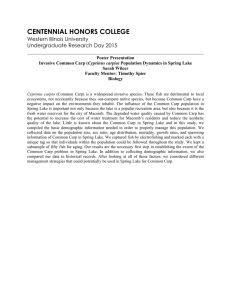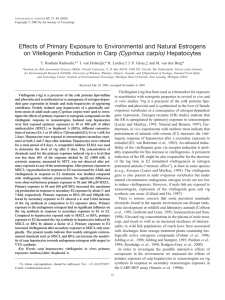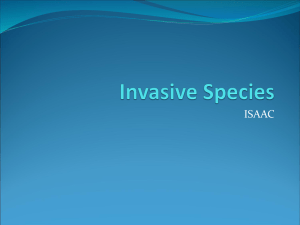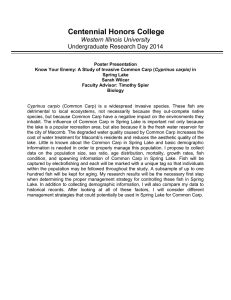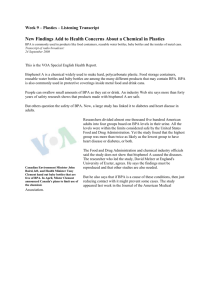Effects of bisphenol A-related diphenylalkanes on vitellogenin production
advertisement
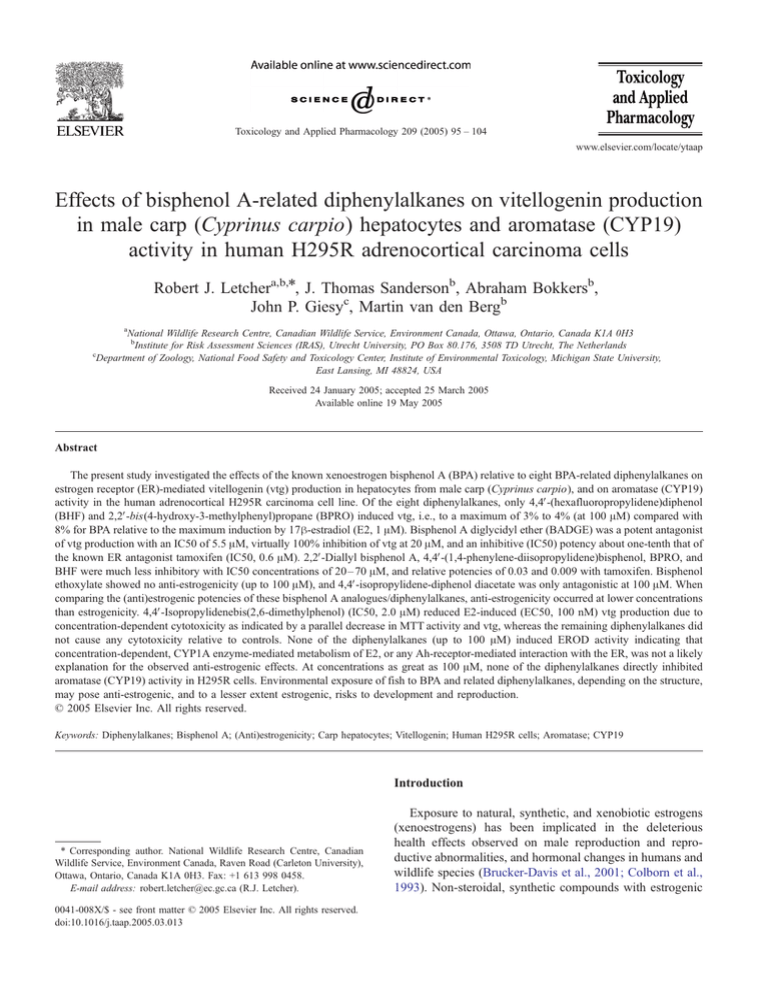
Toxicology and Applied Pharmacology 209 (2005) 95 – 104 www.elsevier.com/locate/ytaap Effects of bisphenol A-related diphenylalkanes on vitellogenin production in male carp (Cyprinus carpio) hepatocytes and aromatase (CYP19) activity in human H295R adrenocortical carcinoma cells Robert J. Letchera,b,*, J. Thomas Sandersonb, Abraham Bokkersb, John P. Giesyc, Martin van den Bergb a National Wildlife Research Centre, Canadian Wildlife Service, Environment Canada, Ottawa, Ontario, Canada K1A 0H3 b Institute for Risk Assessment Sciences (IRAS), Utrecht University, PO Box 80.176, 3508 TD Utrecht, The Netherlands c Department of Zoology, National Food Safety and Toxicology Center, Institute of Environmental Toxicology, Michigan State University, East Lansing, MI 48824, USA Received 24 January 2005; accepted 25 March 2005 Available online 19 May 2005 Abstract The present study investigated the effects of the known xenoestrogen bisphenol A (BPA) relative to eight BPA-related diphenylalkanes on estrogen receptor (ER)-mediated vitellogenin (vtg) production in hepatocytes from male carp (Cyprinus carpio), and on aromatase (CYP19) activity in the human adrenocortical H295R carcinoma cell line. Of the eight diphenylalkanes, only 4,4V-(hexafluoropropylidene)diphenol (BHF) and 2,2V-bis(4-hydroxy-3-methylphenyl)propane (BPRO) induced vtg, i.e., to a maximum of 3% to 4% (at 100 AM) compared with 8% for BPA relative to the maximum induction by 17h-estradiol (E2, 1 AM). Bisphenol A diglycidyl ether (BADGE) was a potent antagonist of vtg production with an IC50 of 5.5 AM, virtually 100% inhibition of vtg at 20 AM, and an inhibitive (IC50) potency about one-tenth that of the known ER antagonist tamoxifen (IC50, 0.6 AM). 2,2V-Diallyl bisphenol A, 4,4V-(1,4-phenylene-diisopropylidene)bisphenol, BPRO, and BHF were much less inhibitory with IC50 concentrations of 20 – 70 AM, and relative potencies of 0.03 and 0.009 with tamoxifen. Bisphenol ethoxylate showed no anti-estrogenicity (up to 100 AM), and 4,4V-isopropylidene-diphenol diacetate was only antagonistic at 100 AM. When comparing the (anti)estrogenic potencies of these bisphenol A analogues/diphenylalkanes, anti-estrogenicity occurred at lower concentrations than estrogenicity. 4,4V-Isopropylidenebis(2,6-dimethylphenol) (IC50, 2.0 AM) reduced E2-induced (EC50, 100 nM) vtg production due to concentration-dependent cytotoxicity as indicated by a parallel decrease in MTT activity and vtg, whereas the remaining diphenylalkanes did not cause any cytotoxicity relative to controls. None of the diphenylalkanes (up to 100 AM) induced EROD activity indicating that concentration-dependent, CYP1A enzyme-mediated metabolism of E2, or any Ah-receptor-mediated interaction with the ER, was not a likely explanation for the observed anti-estrogenic effects. At concentrations as great as 100 AM, none of the diphenylalkanes directly inhibited aromatase (CYP19) activity in H295R cells. Environmental exposure of fish to BPA and related diphenylalkanes, depending on the structure, may pose anti-estrogenic, and to a lesser extent estrogenic, risks to development and reproduction. D 2005 Elsevier Inc. All rights reserved. Keywords: Diphenylalkanes; Bisphenol A; (Anti)estrogenicity; Carp hepatocytes; Vitellogenin; Human H295R cells; Aromatase; CYP19 Introduction * Corresponding author. National Wildlife Research Centre, Canadian Wildlife Service, Environment Canada, Raven Road (Carleton University), Ottawa, Ontario, Canada K1A 0H3. Fax: +1 613 998 0458. E-mail address: robert.letcher@ec.gc.ca (R.J. Letcher). 0041-008X/$ - see front matter D 2005 Elsevier Inc. All rights reserved. doi:10.1016/j.taap.2005.03.013 Exposure to natural, synthetic, and xenobiotic estrogens (xenoestrogens) has been implicated in the deleterious health effects observed on male reproduction and reproductive abnormalities, and hormonal changes in humans and wildlife species (Brucker-Davis et al., 2001; Colborn et al., 1993). Non-steroidal, synthetic compounds with estrogenic 96 R.J. Letcher et al. / Toxicology and Applied Pharmacology 209 (2005) 95 – 104 or anti-estrogenic activity include medicines (e.g., tamoxifen), pesticides (e.g., methoxychlor, lindane, toxaphenes), and plasticizers such as bisphenol A (BPA), para-nonylphenol (Hoivik et al., 1998; Smeets et al., 1999a, 1999b). Males of various fish species exposed to xenoestrogens such as BPA, para-nonylphenol under laboratory conditions, or via wastewater effluent have shown increased levels of the estrogen-inducible yolk precursor protein vitellogenin (vtg), inhibited testicular growth and abnormalities, and formation of intersex gonads (Nicolas, 1999; Yamanaka et al., 1998). BPA is one of many diphenylalkanes that are raw materials for the production of polymers such as polycarbonates, epoxy, and phenolic resins, polyesters, and polyacrylates, and are used commercially in plastics and coatings in the dental and food industry. For example, concentrations of BPA diglycidyl ether (BADGE) were measured in tuna and oil extracts from cans from four European countries, with inner-coatings containing BADGE (Berger and Oehme, 2000; Berger et al., 2001). BADGErelated compounds were identified that originated from reactions of the glycidyl ethers with bisphenols, phenol, butanol, water, and hydrochloric acid. In tuna up to 3.7 mg/g were found for the BADGE hydrochlorination product, bisphenol F diglycidyl ether (BFDGE + 2 HCl) in tuna. The highest concentrations were 20 mg/g in tuna and 43 mg/g in the oil phase. BADGE and BPA have also been measured in composites and sealants used in the dentistry, as well as the saliva of recently treated patients (Olea et al., 1996). BPA, as an additive or hydrolyzed BADGE product, was measured in saliva at 3– 20 Ag/mL. BPA mimics the activity of estrogens such as 17hestradiol (E2) via interaction with either a- and h-estrogen receptors (ERs). BPA was found to have a similar relative binding affinity with human ERaand ERh proteins, which was ¨1000-fold less than for E2 (Kuiper et al., 1998). Furthermore, BPA similarly stimulated ERa and/or ERhmediated transcriptional activity in transfected 293 human embryonal kidney and HepG2 human hepatoma cells, at treatment concentrations of 100 –1000 nM (Could et al., 1998; Kuiper et al., 1998). BPA is considered a model xenoestrogen despite the fact that the in vitro estrogenic potency is generally 15,000 times less than that of E2. In addition to BPA, several related diphenylalkanes have demonstrated estrogenic activity in vitro including increased proliferation of MCF-7 human breast cancer cells (Perez et al., 1998). For BPA-related diphenylalkanes, and those with ester and ether type bonds, MCF7-treated cells could cleave these bonds and release para-hydroxy groups (and are thus more BPA-like), which activated their proliferative estrogenic effects. For example, identified in extracts of resins composites used in dentistry, BADGE treatments of MCF7 cells at high concentrations of 10 AM have been shown to estrogenic, although with no competitive binding affinity for the estrogen receptor (Olea et al., 1996). Evidence shows that the thermal, chemical, and enzymatic degradation of some BPA-based diphenylalkane polymers represent a source of biologically active monomers (e.g., BADGE) (Climie et al., 1981; Pottenger et al., 2000). Because BPArelated diphenylalkane derivatives are in widespread commercial use and their production is increasing, potential human exposure to estrogenic diphenylalkanes has become a significant environmental issue. A growing number of xenobiotics that possess antiestrogenic activities have been identified, i.e., compounds that antagonize estrogen-dependent processes in target tissues. Pathways of anti-estrogenicity include competitive binding E2 with ERa and/or ERh, down-regulation of ER-mediated responses via aryl hydrocarbon receptor (AhR) cross-talk, and accelerated metabolism of estrogens due to AhRmediated enzyme induction (e.g., cytochrome P4501A (CYP1A)) (Safe and Wormke, 2003). Major examples of synthetic antiestrogens that are active via ER-independent and AhR-dependent mechanisms are polychlorinated dibenzo-p-dioxins (PCDDs) and dibenzofurans (PCDFs), and dioxin-like non- and mono-ortho PCBs. In vitro assays developed for the routine screening of potential xenoestrogens also include competitive ER binding assays and induction of reporter gene expression in transiently or stably infected cell lines (Ankley et al., 1998; Reel et al., 1996). Vitellogenin (vtg) is a precursor of the yolk proteins phosvitin and lipovitelline, and is synthesized in the liver of female, oviparous vertebrates. Vtg synthesis is induced by estrogen-dependent stimulation of gene expression. Although the vtg gene is present, the endogenous plasma concentrations of estrogen are normally too small to induce vitellogenesis in hepatocytes of male and female oviparous vertebrates. Vtg has been used as a biomarker of exposure to (anti)estrogenic compounds in a number of in vivo and in vitro studies with fish, and in particular carp (Letcher et al., 2002; Rankouhi et al., 2004; Rodgers-Gray et al., 2000; Rouhani-Rankouhi et al., 2002; Smeets et al., 1999a, 1999b; Tolar et al., 2001). Smeets et al. (1999b) concluded that in a carp hepatocyte-vtg production (CARPHEP) assay that hepatocytes of male fish origin, rather than female origin, be used when assessing estrogenic potencies of compounds. They found that female hepatocytes produced relatively large basal levels of vtg, whereas uninduced male hepatocytes secreted no detectable vtg. Furthermore, the absolute quantities of vtg produced by E2-treated cells of female origin were some 25-fold higher than in similarly treated cells from males. Nevertheless, dose – response relationships for vtg induction by E2 were virtually identical for male and female hepatocytes. They concluded that from a toxicological point of view, vtg production in male carp is more relevant since there is little basal vtg secretion, and as a result induction of vtg can more easily be detected, which has an obvious advantage for an in vitro screening assay. The objectives of the present study is to determine the estrogenic or anti-estrogenic activity of BPA and eight BPArelated diphenylalkanes in a CARP-HEP assay by measuring the effects on the production of vtg and CYP1A-mediated catalytic activity in exposed hepatocytes from male carp R.J. Letcher et al. / Toxicology and Applied Pharmacology 209 (2005) 95 – 104 (Cyprinus carpio) (Letcher et al., 2002; Rankouhi et al., 2004; Rouhani-Rankouhi et al., 2002; Smeets et al., 1999a, 1999b). Xenobiotic compounds may also disturb endocrine functions through mechanisms other than via interactions with hormone receptors, including interference with aromatase (CYP19) enzyme, which mediates the biosynthesis of estrogens (Sanderson et al., 2001, 2002). Therefore, the present study also investigated the ability of BPA-related diphenylalkanes to directly inhibit aromatase (CYP19) activity (androgen to estrogen conversion) in the human adrenocortical H295R carcinoma cell line (Sanderson et al., 2000). Materials and methods Chemicals. Bisphenol A (BPA), bisphenol ethoxylate (BEO, >99%), 2,2V-diallyl bisphenol A (DAB, 98%), 4,4V-isopropylidenebis(2,6-dimethylphenol) (BTM, 98%), 97 2,2V-bis(4-hydroxy-3-methylphenyl)propane (BPRO, >99%), 4,4V-(1,4-phenylene-diisopropylidene)bisphenol (BDP, >99%), 4,4V-isopropylidene-diphenol diacetate (BDA, 98%), para-cresol (98%), and ortho-cresol (98%) were obtained commercially in the greatest purity available from Sigma-Aldrich (St. Louis, MO, USA). BPA diglycidyl ether (BADGE, >99%) and 4,4V-hexafluoropropylidene)diphenol (BHF, 98%) were purchased from Fluka (Buchs, Switzerland). The chemical structures of the diphenylalkanes are shown in Fig. 1. 17h-Estradiol (E2, >99%), tamoxifen (>99%), and dimethyl sulfoxide (DMSO, 99.9%, Janssen Chimica, Geel, Belgium) were purchased from Sigma (St. Louis, MO, USA). ICI 182,780 was a kind gift from Dr. A. Wakeling (Zeneca Pharmaceuticals, UK). All compounds were prepared as 1000-fold concentrated DMSO stock solutions. CARP-HEP/vtg bioassay. The common carp (C. carpio) used in the carp hepatocyte/vitellogenin (CARP-HEP/VTG) Fig. 1. Chemical structures, names, and abbreviations of BPA and related diphenylalkanes. The hydrogens on the aromatic ring have been omitted for clarity. BPA = bisphenol A; BADGE = bisphenol A diglycidyl ether; BEO = bisphenol ethoxylate; DAB = 2,2V-diallyl bisphenol A; BTM = 4,4V-isopropylidenebis (2,6-dimethylphenol); BPRO = 2,2V-bis(4-hydroxy-3-methylphenyl)propane; BHF = 4,4V-hexafluoropropylidene)diphenol; BDP = 4,4V-(1,4-phenylenediisopropylidene)bisphenol; BDA = 4,4V-isopropylidene-diphenol diacetate. 98 R.J. Letcher et al. / Toxicology and Applied Pharmacology 209 (2005) 95 – 104 bioassay were genetically uniform, all male (XY), F1 hybrid progenies. Further details of the carp, the maintenance of the fish prior to use in the assay, and the perfusion procedure are described in detail in Smeets et al. (1999a, 1999b) and Rouhani-Rankouhi et al. (2002). Briefly, carp hepatocytes were freshly perfused by a two-step retrograde technique, isolated and cultured. The liver was first perfused with Ca2+and Mg2+-free buffer containing EDTA (0.145 M NaCl; 5.4 mM KCl; 5 mM EDTA; 1.1 mM KH2PO4; 12 mM NaHCO3; 3 mM NaH2PO4; 100 mM HEPES; pH 7.5) and followed by a step with the same buffer containing no EDTA and 0.26 mg/ml collagenase D (Boehringer, Mannheim, Germany). The perfused liver sections were filtered through nylon mesh. After removal, mincing, sieving, and washing, the hepatocytes were re-suspended in culture medium. The cell viability was >90% as assessed with trypan blue staining. The isolated hepatocytes were cultured in phenol red-free DMEM/F12 media (D2906, Sigma, St. Louis, MO) supplemented with 14.3 mM NaHCO3, HEPES (final concentration: 20 mM), 50 mg/l gentamycin, 1 AM insulin, 10 AM hydrocortisone, 2% v/v Ultroser SF (steroid-free) serum (Jones Chromatography, Mid Glamorgan, UK), and 2 mg/l of the protease-inhibitor aprotinin (Fluka, Buchs, Switzerland) at pH 7.4. The concentration of the cell suspension was 1.0 106 cells/ml, and 0.18 ml (or 180,000 cells) was added to each well of 96-well tissue plates (Griener, Alphen a/d Rijn, the Netherlands). The plates were maintained at 24 -C for a period of 36 h to acclimatize the cells. The proportion of erythrocytes did not exceed 10% of the hepatocytes. After the 36 h acclimatization period the confluence of the cells was about 70% and were ready for dosing. All DMSO stock solutions of compounds and concentrations were diluted 1000-fold in assay medium for bioscreening in the CARP-HEP/vtg assay. The culture medium (90%) was replaced by assay media (164 AM) containing 10% greater compound concentrations to obtain the desired 1000-fold dilution. After 2 days, the assay medium (90%) was refreshed with new assay medium containing nominal compound and E2 concentrations. After a further 2 days, the medium was transferred to new 96-well plates and frozen at 70 -C until further use. The remaining hepatocytes were used to determine EROD activity, cell viability, or protein content. An indirect competitive ELISA was used to quantify the vtg present in the assay medium. The ELISA procedure, as well as calculations to quantify vtg, has been thoroughly described (Letcher et al., 2002; Rouhani-Rankouhi et al., 2002; Smeets et al., 1999a, 1999b). For each experiment set, an E2 dose – response curve plate was included with concentrations ranging from 0.6 to 6000 nM. An E2-positive control (EC50, 100 nM) was included on all other plates. All E2 and compound concentrations were tested in two separate sets of 6-fold replicates. The final DMSO concentration in the dosing medium did not exceed 0.2% (v/v). cells (ATCC No. CRL-2128) for use in the H295R/CYP19 bioassays have been described in Sanderson et al. (2000, 2001). Briefly, the H295R cells were cultured in the presence of 2% of the steroid-free serum replacement Ultroser SF (Soprachem, France). Cells were grown until almost confluent and then trypsinized and suspended in 75 mL if culture media. Three 24-well cell culture plates were seeded (1 mL in each well) with the cell suspension. After 24 h the medium was changed, and the cells were well attached at about 2 105 cells/well). The direct effect of the test compounds on the aromatase (CYP19) activity in the H295R cells was determined according to previously described in Materials and methods (Letcher et al., 1999; Sanderson et al., 2000, 2001). Briefly, the cells were washed twice with PBS and then exposed to [1h-3H(N)]-androst-4-ene-3,17-dione (28.5 Ci/mmol; specific activity 1054.5 GBq/mmol; Lot No. 3329278; New England Nuclear; NET-926). CYP19 catalyzes the conversion of [1h-3H(N)]-androst-4-ene-3,17-dione to estrone and 3 H2O. The H295R cells were co-incubated with [1h-3H]androstenedione and BPA-related diphenylalkanes. The same BPA and BPA-related diphenylalkanes and concentrations were screened in the H295R/CYP19 bioassay. The CYP19 activity in the H295R assays was determined from the radioactivity of extracted 3H2O. Correction was made for the effect of solvent, background radioactivity, dilution factor, the 3H distribution on the [1h-3H]-androstenedione, and the specific activity of [1h-3H]-androstenedione. H295R/CYP19 bioassay. The details of culturing and maintenance of the human H295R adrenocortical carcinoma Cell viability. The viability of the carp hepatocytes, exposed for 4 days to the various compounds, was assessed Estrogenic and antiestrogenic activity in the CARP-HEP/vtg assay. To determine the effects on vtg production in the CARP-HEP assay, 2 sets of n = 6 replicates were performed for the estrogenicity and anti-estrogenicity screens for all compounds and concentrations. Antiestrogenic activity of the test compounds was assessed in the in vitro assays using the same nominal concentrations and procedures used in the estrogenicity screening. In the CARP-HEP/vtg assay, the hepatocytes were co-administered with 100 nM (EC50) of E2 and the test compounds. Concentrations of 0.1, 1.0, and 10 AM of the known competitive ER antagonist tamoxifen were included as positive controls in the anti-estrogenicity experiments. An anti-estrogenic effect was defined by the capacity an antagonist to inhibit the vtg production induced by E2. The percentage of the remaining E2-induced response (%RR) is calculated according to the following: %RR = ((A compound+E2 A control) / (A E2 A control)) 100%, where A compound+E2, A control, and A E2 are the average activity of the test wells, control wells, and wells incubated with E2 alone, respectively. A compound that is not antagonistic will elicit a %RR of 100%, i.e., the response of the co-administered concentration of E2 will be the same as the E2 concentration administered alone. R.J. Letcher et al. / Toxicology and Applied Pharmacology 209 (2005) 95 – 104 by determining changes in the mitochondrial succinate dehydrogenase-mediated metabolism of the substrate 3-(4,5dimethyl-thiazol-2yl)-2,5-diphenyltetrazolium bromide (MTT), or the MTT activity according to Denizot and Lang (1986). The MTT activity in the remaining monolayer of hepatocytes after the vtg-containing solution was harvested was determined according to Smeets et al. (1999a) and Letcher et al. (2002) with minor modifications. The viability of the exposed H295R cells was determined in the same manner, but including minor modifications according to Sanderson et al. (2000) and Letcher et al. (1999). EROD activity and protein content in the carp hepatocytes. The diphenylalkane compounds were assessed for the ability to interact with the AhR and induce CYP1A enzyme activity. After vtg harvesting, the carp hepatocytes were frozen or used immediately for the determination of CYP1A enzyme activity by measurement of ethoxyresorufinO-deethylase (EROD) activity (Burke and Mayer, 1974). 2,3,7,8-Tetrachloro-dibenzo-p-dioxin (TCDD) concentrations of 0.3, 1.0, 10, 100, and 1000 pM were included as positive controls. Protein content of the exposed carp hepatocytes and H295R cells was determined according to the procedure of Lowry et al. (1951) and Rutten et al. (1987), with some modifications. For the CARP-HEP assays, after vtg harvesting, the hepatocytes were washed twice with 200 Al of phosphate-buffered saline (PBS). An aqueous solution of 0.5% Triton X-100 (v/v, 200 Al) was then added. The plates were frozen at 70 -C for at least 2 h. For both the carp hepatocytes and H295R cells, after thawing to room temperature, the protein content in each well was diluted, if necessary, for protein determination using a BSA standard curve. EROD activity was not measured in the H295R cells. Concentration – response curves, calculations, and statistics. Concentration – response relationships are described by the sigmoidal function y = a 0 + a 1 / (1 + exp((a 2 + x) / a 3)) (SlideWrite Plus 4.0, Advanced Graphics Software, Carlsbad, CA), in which y is the remaining amount of vtg production (%RR), and x is the logarithm of the treatment concentration. For estrogenic effects, vtg levels were normalized to the maximum levels induced by E2, and expressed as a percent of this maximum level. For anti-estrogenic effects, the levels were normalized to the vtg level induced by the co-administered E2 concentration alone. The statistical significance of the differences between compound-treated and control hepatocytes was determined using a two-way ANOVA (P < 0.05). Results The LOEC (4.1 nM) and EC50 (¨100 nM) concentrations of E2 for vtg production in the CARP-HEP assay were similar to the findings by Smeets et al. (1999a, 1999b). 99 E2-induced vtg production (EC50) was inhibited essentially 100% at tamoxifen concentrations >10 AM (Table 1). Tamoxifen alone did not induce vtg production up to 10 AM. Initial screening of the diphenylalkanes and the cresol compounds (at 10 AM and 100 AM) in the CARP-HEP/vtg assay are shown in Fig. 2. At the 100 AM treatment level, BPA, BPRO, and BHF were the only diphenylalkanes that demonstrated estrogenic activity, i.e., about 3%, 5%, and 8% maximum induction, respectively, in comparison to the maximum vtg production induced by E2 (1000 nM). For BHF, at the 10 AM treatment level there was also a significant induction of vtg. Initial screening of the diphenylalkanes (at 10 AM and 100 AM) co-incubated with E2 (EC50, 100 nM) in the CARP-HEP/vtg assay indicated that BADGE, BTM, and para-cresol were the most potent anti-estrogens (<10 AM), followed by DAB, BPRO, BHF, BDP (>10 AM), BDA, and ortho-cresol (<100 AM), and finally by BEO, which had no significant (P < 0.05) antagonistic effect at 100 AM (Fig. 3). The IC50 values for the inhibition of E2-induced vtg production by BADGE, BTM, DAB, BPRO, BHF, BDP, para-cresol, and ortho-cresol are summarized in Table 1. The IC50 for BADGE was the lowest, making BADGE about one-tenth as potent as tamoxifen (Table 1, Fig. 4). With the exception of BTM, at the 10 AM or 100 AM treatment level none of the diphenylalkanes or cresol compounds significantly (P < 0.05) altered the MTT activity relative to DMSO-dosed hepatocytes (negative controls). BTM concentration-dependently decreased MTT activity (Fig. 5A), which was parallel to the concentration-dependent antagonism of E2-induced vtg production (Fig. 5B). Carp hepatocytes possess inducible CYP1A activity. All concentrations of the diphenylalkane and cresol compounds, with the exception of BEO, were evaluated for potential CYP1A enzyme induction via interaction with the Ah Table 1 Inhibitory potencies of BPA-related diphenylalkanes (Fig. 1) and tamoxifen on E2-induced (100 nM) vitellogenin (vtg) production in the CARP-HEP assay Diphenylalkane IC50 (AM) Relative inhibition potency (IC50 tamoxifen/IC50) Maximum Vtg inhibition (at 100 AM) as a % of E2-mediated induction BADGE BEO DAB BTM BPRO BHF BDP BDA para-cresol ortho-cresol Tamoxifen 5.5 N/A 22.4 2.0 64.8 68.4 63.7 N/A 8.1 72.7 0.6 0.1 N/A 0.03 0.3 0.009 0.009 0.009 N/A 0.07 0.008 1.0 100 N/A 99 100 95 99 83 47 99 64 94* *Maximum inhibition reached at 10 AM. 100 R.J. Letcher et al. / Toxicology and Applied Pharmacology 209 (2005) 95 – 104 Fig. 2. Percent vtg induction of diphenylalkanes relative to maximum E2 (1000 nM) induction in the CARP-HEP assay. Vtg induction by 0.0001, 0.001, and 0.01 nM E2 (lower part of the E2 induction curve) is shown for comparison. The asterisk indicates a significant (P < 0.05) increase from zero induction. Error bars are the TSD (n = 6 replicates). receptor. None of the compounds or concentrations tested (up to 100 AM) resulted in the induction of EROD activity above the detection limit of 1.7 pmol/min/mg protein) (not shown). The diphenylalkanes and cresols were screened in the H295R cells to determine any inhibitory or inductive effects on aromatase activity. The aromatase activity in the DMSO controls was not significantly different (P < 0.05) from the activity of non-exposed cells. Therefore, activities in DMSO and non-exposed cells were set to 100% activity. Inhibition of aromatase activity by the positive control 4-HA was in all cases greater than 95%. With the exception of DAB, none of the diphenylalkanes and cresols significantly inhibited aromatase activity in H295R cells at concentrations up to 20 AM. The DABmediated antagonism of aromatase activity (IC50 of 70 AM, top a maximum inhibition of about 75%) was parallel to a concentration-dependent decrease in MTT activity, suggesting that the decline in aromatase activity was secondary to cell death. Discussion Based on the observed (anti)estrogenic effects for the BPA analogues tested in our study some preliminary conclusions can be drawn about the structural requirements that are necessary to elicit (anti)estrogenic effects in the Fig. 3. Percent inhibition of E2-induced (EC50, 100 nM) vtg production by the diphenylalkanes in the CARP-HEP assay. The asterisk indicates a significant (P < 0.05) decrease from the E2 control (only 100 nM). Error bars are the TSD (n = 6 replicates). The dotted line is the IC50 concentration. R.J. Letcher et al. / Toxicology and Applied Pharmacology 209 (2005) 95 – 104 Fig. 4. A representative concentration – response curves for the percent inhibition of E2-induced (EC50, 100 nM) vtg production by BADGE (Fig. 1) versus the known ER-antagonist tamoxifen. Error bars are the TSD (n = 6 replicates). CARP/HEP assay. The phenolic moiety appears to play an essential role in stimulating the estrogen-dependent vtg synthesis as was shown by the significant potency of BPA within this group of structural analogues. This prerequisite is confirmed by the observed estrogenicity of BHF, which like BPA possesses two unsubstituted phenolic groups. Substitution adjacent to the hydroxy groups decreased the potency for vtg synthesis but it depended on the nature and number of the substituents. In our experiments, induction properties for vtg synthesis decreased in the order one adjacent methyl group > two adjacent methyl groups > an allyl group. In addition, if the phenol moiety in the diphenylalkane molecule is fully replaced by, e.g., a diglycidyl ether or acetate group, the inductive properties for vtg production are lost. Since vtg synthesis is an ERmediated process, these different potencies likely represent various molecular interactions that involve activation via the 101 ER. Differences in estrogenic potencies related to the structure of diphenylalkanes have been observed earlier in the MCF-7 cell line (Perez et al., 1998). Besides the phenolic structure of these compounds, the length and nature of the substituents on the bridging carbon play an essential role in determining interactions with the ERs (Perez et al., 1998). Another aspect that may have played a role in the differential potencies of these diphenylalkanes is bioactivation. The estrogenic potency of BPA has been observed to be significantly increased when incubated with a rat S9 fraction and this bioactivation depended on microsomal and cytosolic constituents (Yoshihara et al., 2001). The role of specific human hepatic CYP enzymes in the metabolism of BPA has been studied and it was concluded that especially CYP2C enzymes played a significant role (Niwa et al., 2001). However, it has been shown for carp hepatocytes that the major CYP activity in due to CYP1A isoforms relative to, e.g., CBY2B-like mediated activities (Smeets et al., 1999a, 1999b). The involvement of CYP-mediated activity in the possible bioactivation of diphenylalkanes to more estrogenic compounds requires further investigation. However, earlier studies with these carp hepatocytes with methoxychlor and a potent CYP1A inducer, TCDD, could not find evidence for bioactivation of this environmental estrogen (Smeets et al., 1999a). This may be due to factors such as relatively short exposure times to the hepatocytes. With the exception of BTM, the diphenylalkanes inhibited E2-induced vtg production in the CARP/HEP assay. Among these congeners, BADGE was the most potent inhibitor of vtg synthesis with a potency that is about ten-fold less than that of tamoxifen. When observing the anti-estrogenic effects of these diphenylalkane analogues, a specific role of the hydroxy group of phenolic moiety or specific substituents appears less pronounced in our experiments. Fig. 5. Concentration – response relationships for (A) MTT activity (cytotoxicity) and (B) inhibition of E2-induced vitellogenin (vtg) production in carp hepatocytes exposed to the diphenylalkane 4,4V-isopropylidenebis(2,6-dimethylphenol) (BTM, Fig. 1). Error bars are the TSD (n = 6 replicates). The significance of the BTM effect relative to the (A) DMSO control and (B) E2 (100 nM) controls is indicated (*P < 0.05). 102 R.J. Letcher et al. / Toxicology and Applied Pharmacology 209 (2005) 95 – 104 Basically three different pathways could explain the anti-estrogenicity of the diphenylalkanes and these include the following: (1) accelerated metabolism of estrogens due to enzyme induction, (2) down-regulation of ER-mediated responses via the AhR cross-talk, and (3) competitive binding to the ER. Earlier studies with carp or rainbow trout hepatocytes have also addressed the possibility of anti-estrogenicity through enhanced metabolism due to enzyme induction (Navas and Segner, 2000; Smeets et al., 1999b). In the case of (3), in spite of the fact that both studies examined potent CYP inducers such polychlorinated dibenzo-p-dioxins (PCDDs), PCBs, or PAHs, no evidence was found that E2 metabolism explained the observed anti-estrogenicity. Another possibility for the anti-estrogenicity comes from possible down-regulation of estrogen-mediated processes through cross talk with the AhR (Anderson et al., 1996). Several studies have shown that Ah receptor agonists such as PCDDs and non-ortho-chlorinated PCB congeners can down-regulate estrogen-mediated processes (Safe, 1995; Safe and Wormke, 2003). The down-regulation of vtg synthesis due to dioxin-like compounds has been studied earlier in the CARP/HEP assay (Smeets et al., 1999b). For these compounds a similar rank order potency for CYP1A induction and anti-estrogenicity was observed, strongly indicating the involvement of an AhR-mediated process. Based on good correlations between PAH-mediated CYP1A induction and anti-estrogenicity in trout hepatocytes a similar mechanism via cross talk with the AhR was suggested to occur (Navas and Segner, 2000). For PAHs and dioxin-like compounds a similar crosstalk between the AhR and ER was observed in a human endometrial cell line and this resulted in a reduction of ER-mediated responses (Wormke et al. 2000). However, in the MCF-7 breast tumor cell line it was also observed that metabolites of PAHs could act as anti-estrogens through interactions with the ER, but also possibly by increased metabolism and depletion of E2 (Arcaro et al., 1999). In our experiments with carp hepatocytes and diphenylalkane analogues it seems unlikely that these compounds are anti-estrogenicity via cross talk with the AhR, as no CYP1A induction could be observed. Thus, a direct interaction between the diphenylalkanes and the ER appears far more likely. In this case these compounds do have to compete with E2 for binding to the ER. None of the diphenylalkanes and cresols significantly inhibited aromatase activity in H295R cells at concentrations up to 20 AM. This may suggest that hepatic steroidogenic activity in humans is not significantly affected by BPA-related diphenylalkanes. However, this may not be necessarily true in carp liver for other target tissues in carp where aromatase is significant steroidogenic process. Ovarian aromatase activity was recently reported in common carp from the Ebro River in Spain (Lavado et al., 2004). In this study, it was concluded that sewage effluent in the area was a major causal factor leading to the detected estrogenic effects in carp, including low ovarian aromatase activity, and reduced testosterone and estradiol in males in Zaragoza and Canal Imperial de Aragon (an agricultural area), which suggest decreased estrogen synthesis, and possibly reduced sex hormone excretion in carp. In conclusion, our experiments showed that some BPArelated diphenylalkanes have strong anti-estrogenic properties and are rather weakly estrogenic activity in vitro in a CARP-HEP assay. For one compound, BADGE, the antiestrogenic properties are within one order of a magnitude of that of tamoxifen. These findings would suggest that carp, and perhaps other fish species and populations, exposed to BPA-related diphenylalkanes, depending on the structure, may pose a risk for development and reproduction. This may be especially true with respect to antiestrogenic effects via ER-dependent processes. However, at the population level for carp, the overall estrogenic versus anti-estrogenic compound mixture impact is more complex. Sole et al. (2002) reported the feral female and male carp living in warm waters of Southern Europe, two tributaries (the Anoia and the Cardener) of the Llobregat River in northeast Spain, and known to be polluted by estrogenic compounds, had elevated levels of vtg in the plasma and liver and elevated EROD activity in the liver. This would suggest that a complexity of estrogen-disrupting compounds in human effluent discharges in this Spanish river system, which perhaps includes BPA-related diphenylalkanes, and that at a population level for carp the overall exposure affect is estrogenic rather than antiestrogenic. However, contrary results for feral carp were reported in male feral carp from the lower course of another Spanish River, the Ebro, and downstream from sewage treatment plants (Lavado et al., 2004). In these male carp low plasmatic vtg levels in male carp were found. Perez et al. (1998) generally concluded that the extent of environmental exposures to BPA-related diphenylalkanes is presently not well defined, i.e., quantitative daily exposure and absorption, and toxicokinetics and health impacts. Regardless, these compounds should be regarded as (anti)estrogenic xenobiotics in humans, which may also be likely for aquatic wildlife in close proximity to discharges and effluents from substantially urbanized areas. Acknowledgments This study was finally supported by an internal research grant from Utrecht University. We thank Ineke van Holsteijn (IRAS) for her invaluable laboratory assistance. References Anderson, M.J., Miller, M.R., Hinton, D.E., 1996. In vitro modulation of 17h-estradiol-induced vitellogenin synthesis: effects of cytochrome P4501A1 inducing compounds on rainbow trout (Oncorhynchus mykiss) liver cells. Aquat. Toxicol. 34, 327 – 350. R.J. Letcher et al. / Toxicology and Applied Pharmacology 209 (2005) 95 – 104 Ankley, G., Mihaich, E., Stahl, R., et al., 1998. Overview of a workshop on screening methods for detecting potential (anti-) estrogenic/androgenic chemicals in wildlife. Environ. Toxicol. Chem. 17, 68 – 87. Arcaro, K.F., O’Keefe, P.W., Yang, Y., Clayton, W., Gierthy, J.F., 1999. Anti-estrogenicity of environmental polycyclic aromatic hydrocarbons in human breast cancer cells. Toxicol. Sci. 133 (2 – 3), 115 – 127. Berger, U., Oehme, M., 2000. Identification of derivatives of bisphenol A diglycydyl ether and Novolac glycidyl ether in can coatings by liquid chromatography/ion trap mass spectrometry. J. AOAC Int. 83, 1367 – 1376. Berger, U., Oehme, M., Girardin, L., 2001. Quantification of derivatives of bisphenol A diglycydyl ether (BADGE) and novolac glycidyl ether (NOGE) migrated from can coatings into tuna by HPLC/fluorescence and MS detection. Fresenius’ J. Anal. Chem. 369, 115 – 123. Brucker-Davis, F., Thayer, K., Colborn, T., 2001. Significant effects of endogenous hormonal changes in humans: considerations for low-dose testing. Environ. Health Perspect. 109, 21 – 26. Burke, M.D., Mayer, R.T., 1974. Ethoxyresorufin: direct fluorometric assay of a microsomal-O-dealkylation which is preferably inducible by 3-methylchloanthrene. Drug Metab. Dispos. 2, 583 – 588. Climie, I.J.G., Hutson, D.H., Stoydin, G., 1981. Metabolism of the epoxy resin component 2,2-bis[4-(2,3-eopxypropoxy)phenyl]propane, the diglycidyl ether of bisphenol A (DGEBPA) in the mouse: Part I. A comparison of the fate of a single dermal application and of a single oral dose of 14C-DGEBPA. Xenobiotica 11, 391 – 399. Colborn, T., vom Saal, F.S., Soto, A.M., 1993. Developmental effects of endocrine-disrupting chemicals in wildlife and humans. Environ. Health Perspect. 101, 378 – 384. Could, J.C., Leonard, L.S., Maness, S.C., Wagner, B.L., Conner, K., Zacharewski, T., Safe, S., McDonnell, D.P., Gaido, K.W., 1998. Bisphenol A interacts with the estrogen receptor a in a distinct manner from estradiol. Mol. Cell. Endocrinol. 142, 203 – 214. Denizot, F., Lang, R., 1986. Rapid colorimetric assay fro cell growth and survival. Modifications to the tetrazolium dye procedure giving improved sensitivity and reliability. J. Immunol. Methods 89, 271 – 277. Hoivik, D.J., Safe, S.H., Gaido, K.W., 1998. Effects of xenobiotics on hormone receptors. In: Denison, M.S., Helferich, W.G. (Eds.), Toxicant – Receptor Interactions. Taylor and Francis, Philadelphia, pp. 53 – 68. Kuiper, G.G.J.M., Lemmen, J.G., Carlsson, B., Corton, J.C., Safe, S.H., van der Saag, P.T., van der Burg, B., Gustafsson, J.-Å., 1998. Interaction of estrogenic chemicals and phytoestrogens with estrogen receptor h. Endocrinology 139, 4252 – 4263. Lavado, R., Thibaut, R., Raldua, D., Martin, R., Porte, C., 2004. First evidence of endocrine disruption in feral carp from the Ebro River. Toxicol. Appl. Pharmacol. 196, 247 – 257. Letcher, R.J., van Holsteijn, I., Safe, S., Bergman, Å., Norstrom, R.J., Pieters, R., van den Berg, M., 1999. Cytotoxicity and aromatase (CYP19) activity modulation by organochlorines in human placental JEG-3 and JAR choriocarcinoma cells. Toxicol. Appl. Pharmacol. 160, 10 – 20. Letcher, R.J., van der Burg, B., Brouwer, A., Lemmen, J., Bergman, Å., van den Berg, M., 2002. In vitro anti-estrogenic effects of aryl methyl sulfone metabolites of polychlorinated biphenyls and 2,2-bis(4-chlorophenyl)-1,1-dichloroethene on 17h-estradiol-induced gene expression in several bioassay systems. Toxicol. Sci. 69, 362 – 372. Lowry, O.H., Rosebrough, N.J., Farr, A.L., Randall, R.J., 1951. Protein measurement with the Folin phenol reagent. J. Biol. Chem. 193, 265 – 275. Navas, J.M., Segner, H., 2000. Anti-estrogenicity of h-naphthoflavone and PAHs in cultured rainbow trout hepatocytes: evidence for a role of the aryl hydrocarbon receptor. Aquat. Toxicol. 51 (1), 79 – 92. Nicolas, J.-M., 1999. Vitellogenesis in fish and the effects of polycyclic aromatic hydrocarbon contaminants. Aquat. Toxicol. 45, 77 – 90. Niwa, T., Fujimoto, M., Kishimoto, K., Yabusaki, Y., Ishibashi, F., Katagiri, M., 2001. Metabolism and interaction of bisphenol A in human hepatic 103 cytochrome p450 and steroidogenic CYP17. Biol. Pharm. Bull. 24, 1064 – 1067. Olea, N., Pulgar, R., Pérez, P., Olea-Serrano, F., Rivas, A., Novillo-Fertrell, A., Pedraza, V., Soto, A.M., Sonnenschein, C., 1996. Estrogenicity of resin-based composites and sealants used in dentistry. Environ. Health Perspect. 104, 298 – 305. Perez, P., Pulgar, R., Olea-Serrano, F., Villalobos, M., Rivas, A., Metzler, M., Pedraza, V., Olea, N., 1998. The estrogenicity of bisphenol A-related diphenylalkanes with various substituents at the central carbon and the hydroxy groups. Environ. Health Perspect. 106, 167 – 174. Pottenger, L.H., et al., 2000. The relative bioavailability and metabolism of bisphenol A in rats is dependent upon the route of administration. Toxicol. Sci. 54, 3 – 18 (and references therein). Rankouhi, T., Sanderson, J.T., van Holsteijn, I., van Leeuwen, C., Vethaak, A.D., van den Berg, M., 2004. Effects of natural and synthetic estrogens and various environmental contaminants on vitellogenesis in fish primary hepatocytes: comparison of bream (Abramis brama) and carp (Cyprinus carpio). Toxicol. Sci. 81, 90 – 102. Reel, J., Lamb IV, J., Neal, B., 1996. Survey and assessment of mammalian estrogen biological assays for hazard characterization. Fundam. Appl. Toxicol. 33, 288 – 305. Rodgers-Gray, T.P., Jobling, S., Morris, S., Kelly, C., Kirby, S., Janbakash, J., Harries, J.E., Waldock, M.J., Sumpter, J.P., Tyler, C.R., 2000. Longterm temporal changes in the estrogen composition of treated sewage effluent and its biological effects on fish. Envrion. Sci. Technol. 34, 1521 – 1528. Rouhani-Rankouhi, T., van Holsteijn, I., Letcher, R.J., Giesy, J.P., van den Berg, M., 2002. The effects of pre-exposure with environmental and natural estrogen on vitellogenin production in carp (Cyprinus carpio) hepatocytes. Toxicol. Sci. 67, 75 – 80. Rutten, A.A.J.J.L., Falke, H.E., Catsburg, J.F., Topp, R., Blaauboer, B.J., van Holsteijn, I., Doorn, L., van Leeuwen, R., 1987. Interlaboratory comparison of total cytochrome P450 and protein determinations in rat liver microsomes. Arch. Toxicol. 61, 27 – 33. Safe, S., 1995. Modulation of gene expression and endocrine response pathways by 2,3,7,8,-tetrachloro-p-dioxin and related compounds. Pharmacol. Ther. 67, 247 – 281. Safe, S., Wormke, M., 2003. Inhibitory aryl hydrocarbon receptor-estrogen receptor a cross-talk and mechanisms of action. Chem. Res. Toxicol. 16 (7), 807 – 816. Sanderson, J.T., Seinen, W., Giesy, J.P., van den Berg, M., 2000. 2-Chloros-triazine herbicides induce aromatase (CYP19) activity in H295R human adrenocortical carcinoma cells: a novel mechanism for estrogenicity? Toxicol. Sci. 54, 121 – 127. Sanderson, J.T., Letcher, R.J., Heneweer, M., Giesy, J.P., van den Berg, M., 2001. Effects of chloro-s-triazine herbicides and metabolites on aromatase activity in various human cell lines and on vitellogenin production in male carp hepatocytes. Environ. Health Perspect. 109, 1027 – 1032. Sanderson, J.T., Boerma, J., Lansbergen, G.W.A., van den Berg, M., 2002. Induction and inhibition of aromatase (CYP19) activity by various classes of pesticides in H295R human adrenocortical carcinoma cells. Toxicol. Appl. Pharmacol. 182, 44 – 54. Smeets, J.M.W., Rouhani-Rankouhi, T., Nichols, K.M., Komen, H., Kaminsky, N.E., Giesy, J.P., van den Berg, M., 1999. In vitro vitellogenin production by carp (Cyprinus carpio) hepatocytes as a screening method for determining (anti)estrogenic activity of xenobiotics. Toxicol. Appl. Pharmacol. 157, 68 – 76. Smeets, J.M.W., van Holsteijn, I., Giesy, J.P., van den Berg, M., 1999. The anti-estrogenicity of Ah receptor agonists in carp (Cyprinus carpio) hepatocytes. Toxicol. Sci. 52, 178 – 188. Sole, M., Barcelo, D., Porte, C., 2002. Seasonal variation of plasmatic and hepatic vitellogenin and EROD activity in carp, Cyprinus carpio, in relation to sewage treatment plants. Aquat. Toxicol. 60, 233 – 248. Tolar, J.F., Mehollin, A.R., Douglas-Watson, R., Angus, R.A., 2001. Mosquitofish (Gambusia affinis) vitellogenin: identification, puri- 104 R.J. Letcher et al. / Toxicology and Applied Pharmacology 209 (2005) 95 – 104 fication, and immunoassay. Comp. Biochem. Physiol. Part C 128, 237 – 245. Wormke, M., Castro-Rivera, E., Chen, I., Safe, S., 2000. Estrogen and aryl hydrocarbon receptor expression and crosstalk in human Ishikawa endometrial cancer cells. J. Steroid Biochem. Mol. Biol. 72 (5), 197 – 207. Yamanaka, S., Arizono, K., Matsuda, Y., Soyano, K., Urushitani, H., Iguchi, T., Sakakibara, R., 1998. Development and application of an effective detection method for fish plasma vitellogenin induced by environmental estrogens. Biosci. Biotechnol. Biochem. 62, 1196 – 1200. Yoshihara, S., Makishima, M., Suzuki, N., Ohta, S., 2001. Metabolic activation of bisphenol A by rat liver S9 fraction. Toxoicol. Sci. 62, 221 – 227.




